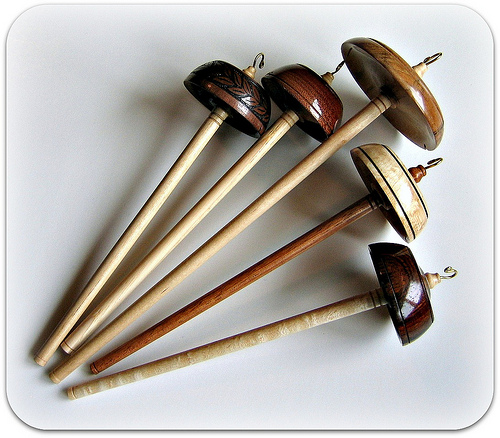Spinning yarn with a drop spindle

If you have ever been interested in spinning fiber into yarn, the drop spindle can seem like an ideal way to start. A lot of people start on a drop spindle and then "move up" to a spinning wheel.
But that's not to say that a drop spindle is a newbie tool, or somehow inferior to a spinning wheel. Until fairly recently (just a few hundred years ago), all of humanity's yarn was spun with drop spindles. And in many parts of the world today, the drop spindle is still very much in use as a production tool.

What is a drop spindle?
To spin fiber into yarn, you have to, well, spin it. A drop spindle is kind of like a spinning top with a long handle. You attach a bit of fiber to the drop spindle, then start it spinning (either by flicking it with your fingers or by rolling it down your leg). As the spindle rotates rapidly, it spins the fiber into yarn.
Drop spindles come in a bewildering variety: supported and suspended; top whorl, bottom whorl and "other." One of the better spindles for the absolute beginner is a top whorl suspended spindle. This is a spindle style that is commonly available, and is considered by many spinners in western countries as a "default spindle."

Image courtesy Flickr/lemurdillo
Why start with a drop spindle?
First of all, cost. A proper spinning wheel starts around $350 and goes up from there - into the thousands of dollars. But you can pick up a pretty good drop spindle for $20-$40. (You can even make one yourself for just a few dollars of materials!)
Drop spindles are also a lot more portable than spinning wheels, which makes them easy to store at home and easy to take with you. You can pack a drop spindle and some spinning fiber into a plastic sports bottle, toss it in your bag, and you're good to go.
A drop spindle is also a much easier tool to learn than a spinning wheel. Wheels have a lot of different parts and levers and bits to adjust and terms to learn. A drop spindle is a drop spindle, full stop.

Image courtesy Flickr/looseends
Which drop spindle should I buy?
Most resources advise that beginners err on the side of buying a heavier spindle rather than a lighter one. A heavier spindle will spin for longer, and will be less likely to wobble and swing. Heavier spindles are also more versatile with practice: it's a lot easier to spin light yarn on a heavy spindle than the opposite.
When faced with an assortment of drop spindles, either ask the seller for their suggestion, or pick one in the middle of the range. Something around 1.5 ounces is probably a good start.
Many stores sell drop spindle kits that come with fiber and instructional materials, which are great for beginners. As of this writing, Pacific Wool and Fiber sells a kit that includes a DVD of Anne Franquemont's "Respect the Spindle" video, plus a spindle and three ounces of fiber, all for only $35.95. That is a killer deal!
![]() Respect The Spindle with Abby Franquemont
Respect The Spindle with Abby Franquemont
How can I learn how to use a drop spindle?
Speaking of Anne Franquemont's "Respect the Spindle" video, this is probably the single best resource for newcomers to the drop spindle. Having consumed a lot of information on beginning drop spindle tutorials, I really feel that Franquemont's video is pretty much all you need. (There is a book of the same name that is very informative, but not as helpful as watching her video.)
You can order the "Respect the Spindle" video as either a DVD or a direct video download from Interweave's website here.

What else do I need?
Practice, practice, practice. As a semi-beginner with the drop spindle, I have found that the amount of information available is as overwhelming as it is contradictory. Once you have learned the basics of spinning, drafting and plying your yarn, everything else is just people bickering about their opinions. Very little of it is helpful.
Spinning is one of those things where the only way to get better at it is to do it. Not read about it; just do it. Set yourself a goal to spin just 15 minutes a day, every day, and you will see yourself improving by leaps and bounds.
Be sure to keep the yarn that you make at the beginning, so that you can remind yourself how far you have come!
Main image courtesy Flickr/weenah3

0 comments